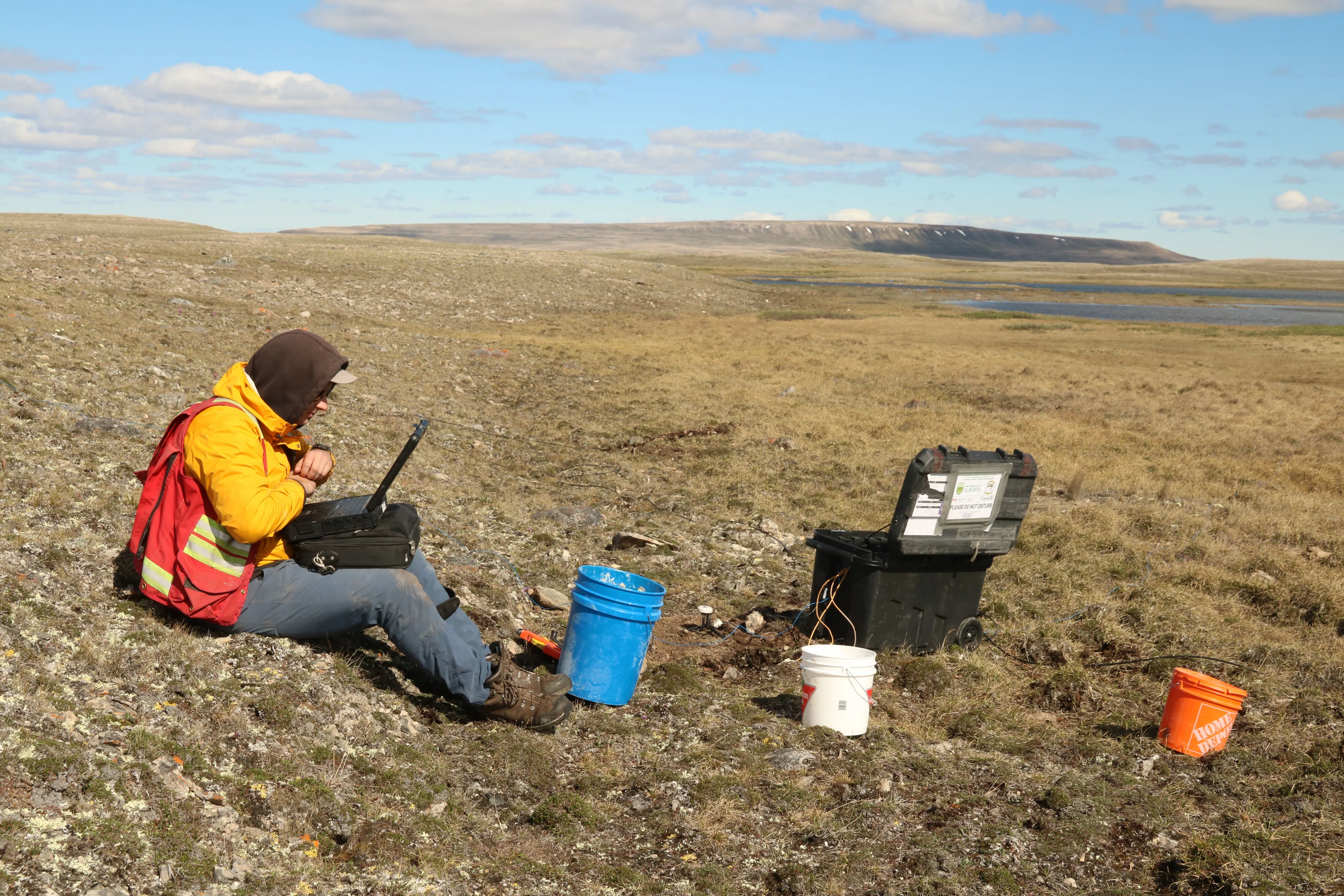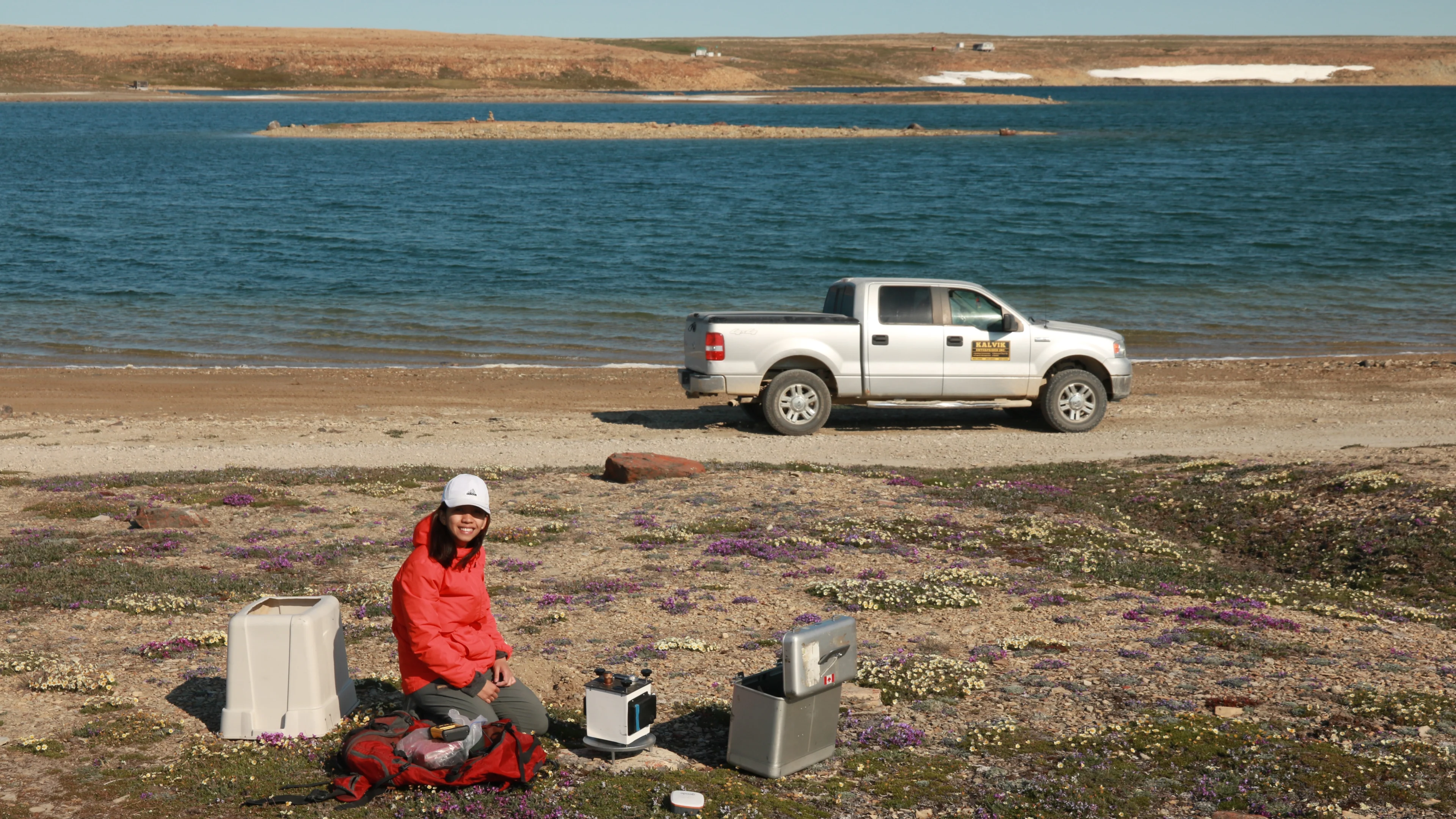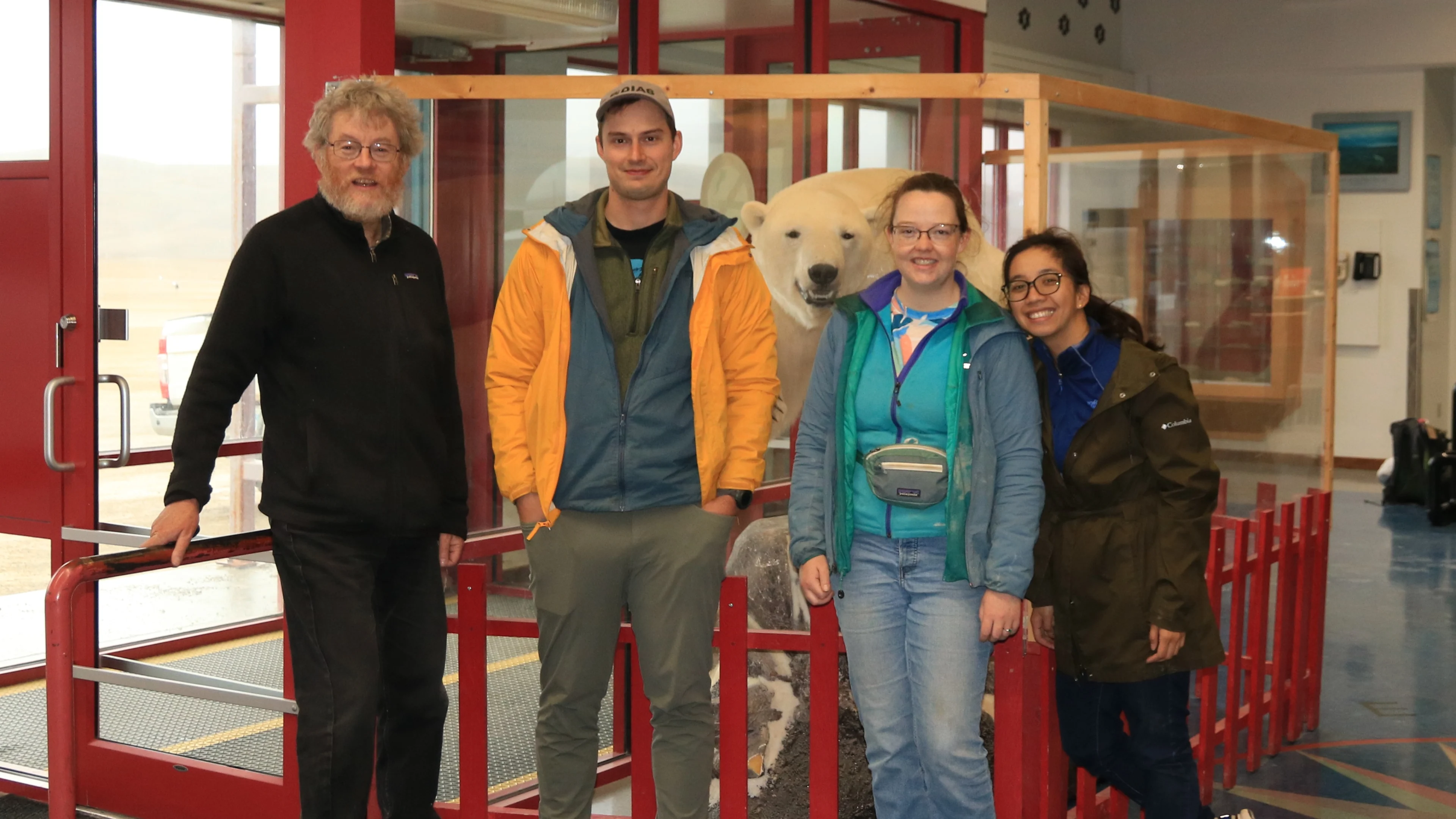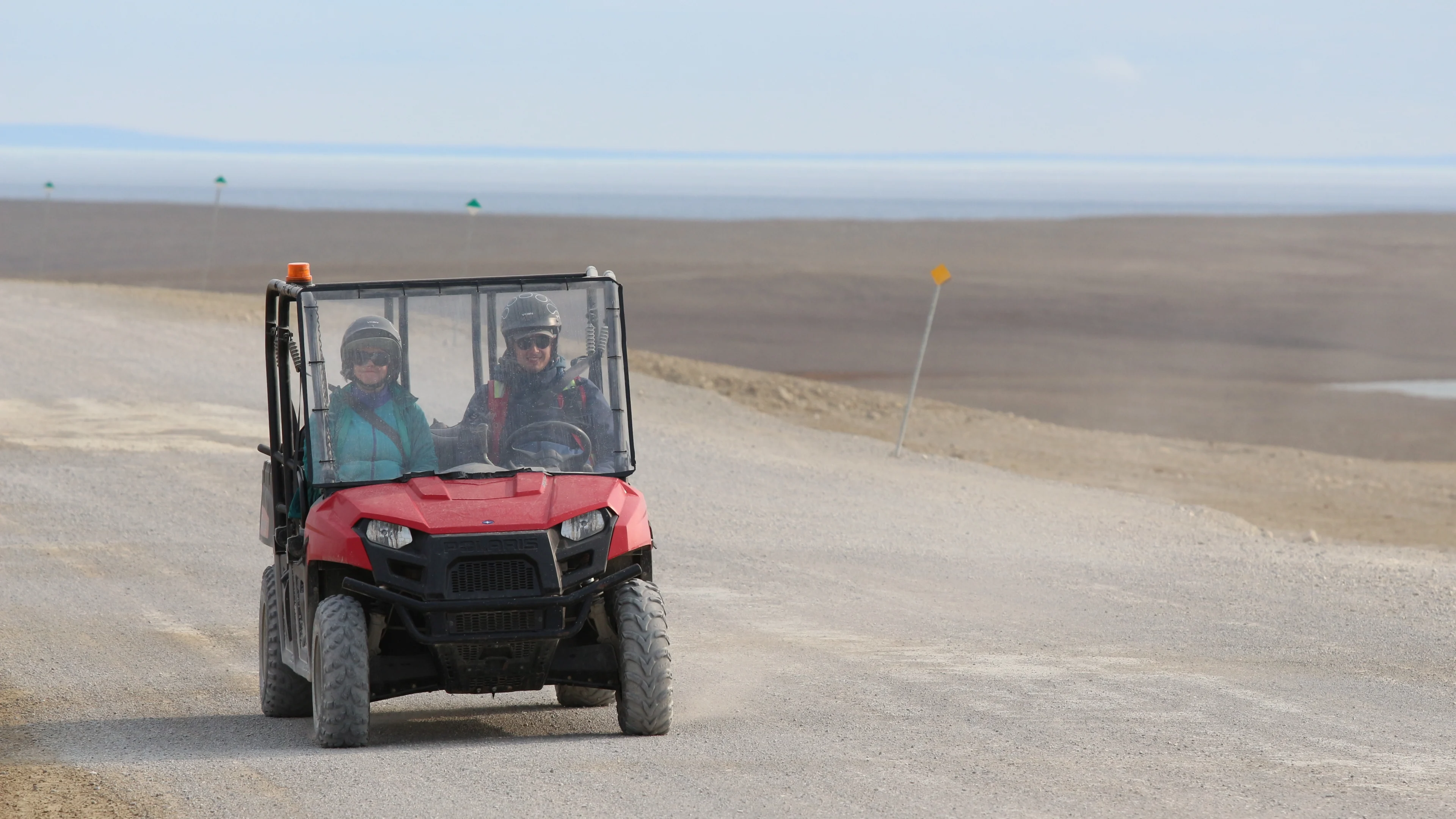
Exploring the possibility of geothermal energy in Nunavut
Nunavut is almost 100 per cent dependent on diesel fuel for power generation. But researchers and Nunavut’s energy corporation have teamed up to explore how geothermal energy could reduce fuel dependence and fight food insecurity in some of the territory’s remote communities.
Spending two weeks each in Cambridge Bay and Resolute Bay, the goal for the researchers has been to explore how geothermal energy may help reduce the territory’s reliance on diesel, and aid with heating homes and sustainable food production across the North.
A unique landscape
The research team — led by University of Alberta professor Martyn Unsworth and funded through federal funding received by the Qulliq Energy Corporation in partnership with Respec Inc. — travelled to two communities in Nunavut this summer.
Unsworth, a professor of geophysics at the University of Alberta for more than 15 years now, said the science behind geothermal energy is simple: using heat generated by rock layers and water below the earth’s surface to generate power and electricity.
“The basic idea has been to see what the rock layer formation is below each community and also other layers that contain water,” he told The Weather Network.
“The water is important because if you want to bring heat up to the surface, you circulate water by pumping it down one borehole and pumping it up another so it carries heat to the surface,” he said of the fieldwork his team undertook in July.

Princess Cosalan using a gravity meter at Cambridge Bay to determine the type of rock present below the surface. (Martyn Unsworth/Submitted)
Unsworth has studied the possibilities and potential of this form of energy in various parts of Canada over the years. In the Yukon and British Columbia, he said you can find hot water beneath the ground that can help generate low-carbon electricity.
In Resolute Bay and Cambridge Bay, the team found the rocks are mostly sedimentary ones: limestone and sandstone. A third community — Baker Lake — which is part of the project but yet to be visited by Unsworth and his team is considered to have a harder rock type.
According to Unsworth, understanding rock formation is the first step in the research, with Nunavut presenting a unique landscape and challenges to do this work.
Harsh weather conditions, even in the summer, as well as safety played a significant role in how the team conducted their fieldwork in the two communities.
“I think the biggest challenge there was was that in summer, it's pretty wet on the surface. So finding your way around swamps and lakes was more of a challenge,” Unsworth said.
“And the challenge in Resolute Bay was that our last week was incredibly windy. The locals were saying this was one of the most sustained periods of wind that they'd seen in summer for quite a while so that slowed things down.”
The team began by working along roads in each community and then carried equipment such as sensors to measure temperatures farther out with the help of ATVs and wildlife monitors hired locally.

Field group leaving Resolute Airport at the end of the project. The research team consisted of (L-R) Martyn Unsworth, Andrew Williamson, Zoe Vestrum (University of Alberta), and Princess Cosalan (Simon Fraser University). (Martyn Unsworth/Submitted)
In both communities, the team found the rocks and water beneath the ground could create enough heat to generate electricity — confirming a hypothesis Unsworth said has been known for communities such as Resolute Bay when oil exploration took place many years ago.
“One of the areas of particular interest was when you drill an oil well, it's common to measure the temperature as you go down in the borehole,” he said.
“They drilled oil wells near Resolute Bay back when they were doing oil exploration in the ‘50s and ‘60s and found a slightly higher than normal temperature there. So it’s long been considered something that should have been followed up on.”
Diesel dependence in the Canadian Arctic
While Nunavut shows potential for geothermal energy, the territory relies almost exclusively on diesel for energy at this time through the operation of 25 stand‐alone diesel power plants in 25 remote fly-in Arctic communities, according to the Qulliq Energy Corporation.
One of the main reasons for this is that given the remoteness of the region and the harsh weather conditions for much of the year, diesel fuel is imported during the summer months and then stored for year-round use.
Each year, approximately 55 million litres of diesel fuel are sealifted to Nunavut communities during the summer shipping season when the sea ice breaks up.
READ MORE: Power to the People: How Tlingit Nation harnesses hydropower, geothermal energy
Sealift costs, the lack of grid interconnection between communities, and unique weather conditions also make servicing the two million square kilometers of the territory costly, with Nunavut’s roughly 15,000 customers paying the highest unsubsidized electricity rates in Canada.
Ian Gates, a professor at the chemical and engineering department at the University of Calgary, has been studying dependence on diesel in communities across Canada’s North.
His research, published last April, focused on what it would really take to move Nunavut away from diesel. Gates said the challenges of implementing alternative energy sources for the territory have a lot to do with infrastructure across communities.
“One of the biggest hurdles we have is that many energy systems we have created — they took decades to build,” he told The Weather Network.
“If you were to add up the cumulative infrastructure purchase that has gone in to supplying energy in Nunavut or within any province of Canada — you're talking decades of investment, adaptations, evolution, new technology moving in and old being thrown out,” Gates added.
“So when you start thinking of energy systems in transition, you don't think of it in terms of two years or five years — you're talking likely a generation and you're talking 25-30 years. So how do you plan for that?”
According to Gates, a key part of implementing alternative and renewable energy in Nunavut will be to make sure the transition is scalable and expandable — and that it can be incorporated in individual structures such as housing and seacans.
“For instance, many have talked about the idea that solar energy or to provide electricity for electric vehicles will be very tough for the existing infrastructure we have,” he said.
“However, if houses are equipped with solar panels like my house is — we supply all of the power we need for our hybrid electric vehicles.”
Heating homes, fighting food insecurity
Both Unsworth and Gates said the benefits of geothermal energy go beyond addressing Nunavut’s dependence on diesel: it may prove to be a solution for heating homes and helping grow food locally to offset the high costs of flying and shipping up food to the communities.
“If you look at the heat budget of many of the communities, there's a very significant amount of the energy that is used for heating space — heating houses and for cooking. But you don't need to be generating electricity necessarily for that,” Unsworth said.
“That's been the experience in many countries around the world where traditionally they started off just using geothermal energy to make electricity and then realized that actually the heat is just as valuable. So people use geothermal heat to heat greenhouses to grow vegetables in Northern Europe where it's too cold outside.”
READ MORE: Harnessing geothermal energy in a Nova Scotia battery factory
Carson Kinney, a PhD student at the University of Waterloo, studied the impact of geothermal energy on sustainable food production in three Northern communities: Resolute Bay in Nunavut, and Moosonee and Pagwa in Ontario.
In Resolute Bay, Kinney’s research published in 2019 found the use of geothermal district heating in greenhouses combined with effective nutrients, water and heat could yield fresh fruits and vegetables with an average cost of 50 per cent lower than the current cost of having them shipped or flown up to the community.
According to him, the low cost and fresher produce through a geothermal energy-powered greenhouse could help fight insecurity whilst also providing a space for the community to come together.
“A lot of Nunavut communities are elderly and so it's a lot harder to go hunting when you're 80 or 70 years old compared to when you're 20 or 30. It also takes away time and access and resources to go out and hunt deer, caribou, or fish for the community,” Kinney told The Weather Network.
“The idea of greenhouses in communities — it provides food security, local produce, and a sense of belonging with the vegetables themselves.”

Zoe Vestrum and Andrew Williamson driving a side-by-side ATV at Resolute. (Martyn Unsworth/Submitted)
The future of energy transition in Nunavut
Geothermal energy presents new possibilities for Canada’s youngest territory and northernmost communities: a sustainable, renewable, and low-carbon energy source that could help alleviate community challenges and costs.
Yet, it would take financial planning and support to tap into geothermal energy and scale it up in a timely manner.
For its part, Qulliq Energy Corporation spokesperson Tina Nleya confirmed the federal and territorial government are actively working together to explore geothermal energy as an alternative energy source for Nunavut.
“Geothermal energy has been proven to be a viable and environmentally-friendly energy source and is currently being used by other Arctic regions for electrical power generation,” she said in an email, noting that the territory is currently undertaking the Nunavut Geothermal Feasibility Assessment, a four-phase in-depth study to determine the territory's capacity for geothermal energy production.
The federal government, through the Canadian Northern Economic Development Agency, is also investing $1.2 million for the Qulliq Energy Corporation to continue on to the second phase of the geothermal assessment, Nleya said, adding the entire assessment projected to cost $2-billion and expected to be completed in 2030-31.
But other challenges arise: the funding needed not only for research but to build the necessary infrastructure, and for communities to be open to such change within their landscape.
According to Unsworth, a key factor in bringing geothermal energy to Nunavut will be whether it is supported and seen as an investment by the communities themselves.
WATCH BELOW: Will Canada use volcanoes to generate energy?
Gates, who echoed this sentiment, added the “social adoption” of alternative energy is critical across the country and how Nunavut’s 25 communities adapt and adopt alternative energy sources moving forward may be a model or a lesson for the rest of the world.
“Globally, we are trying to move from fossil fuel energy sources to cleaner energy sources. And in a way, Nunavut is a model of that because it is so heavily reliant on diesel currently,” Gates said.
“The idea is to move Nunavut to clean energy and to make it such that these are systems that the community wants, that the government and policy supports, and also that it's feasible from an economic point of view,” he added.
“It's a lot of the issues we see in Nunavut but are actually the issues we are facing globally with respect to energy transition.
Thumbnail image: Andrew Williamson collecting magnetotelluric data at Cambridge Bay to study the type of groundwater present in the subsurface. (Martyn Unsworth/ Submitted)
